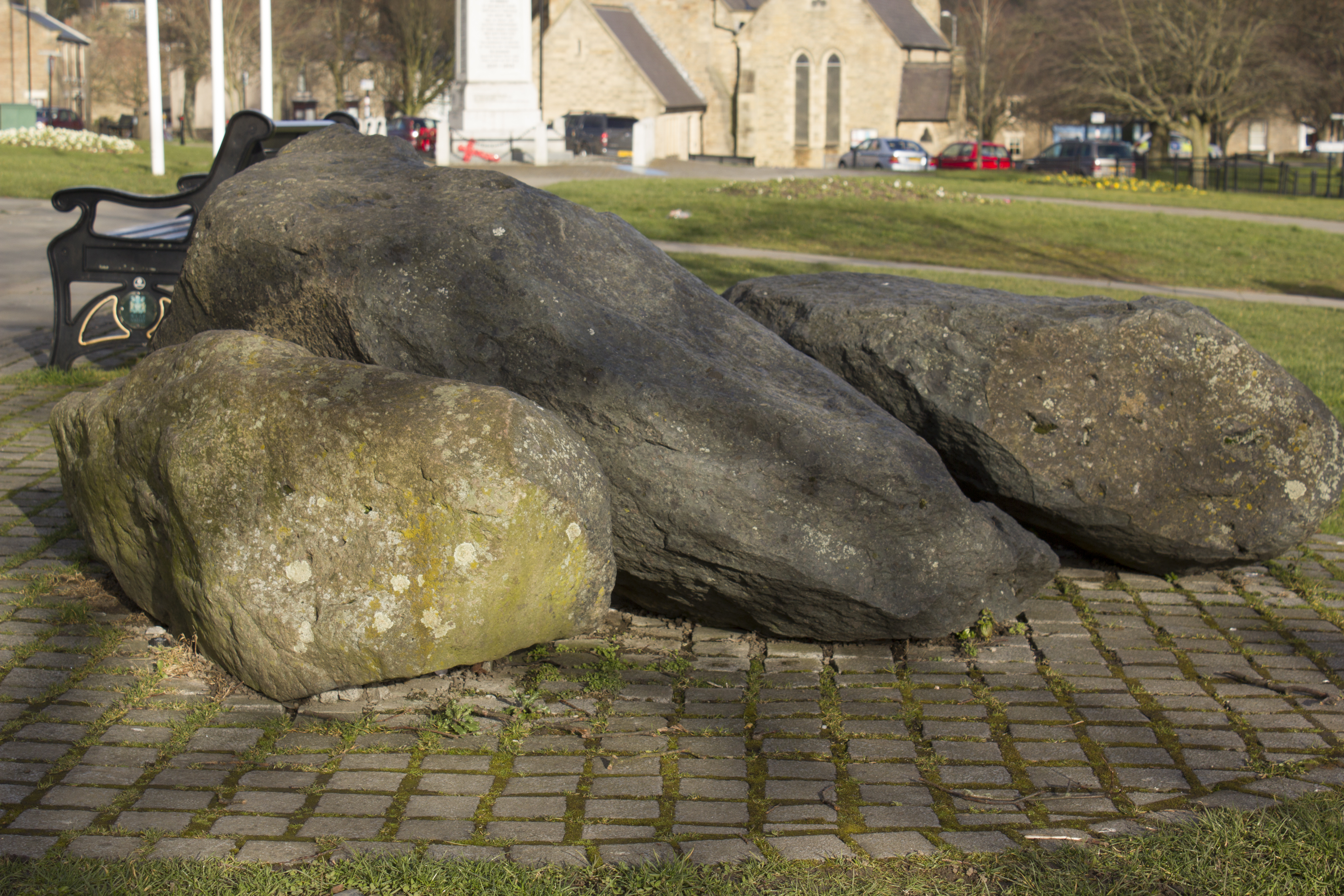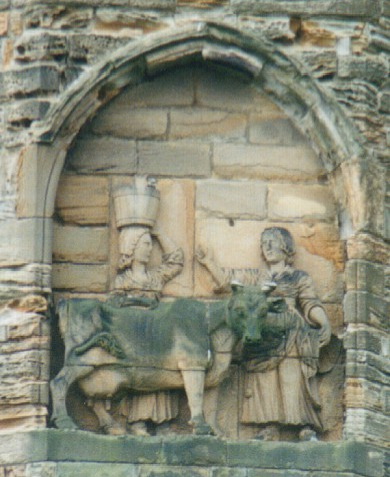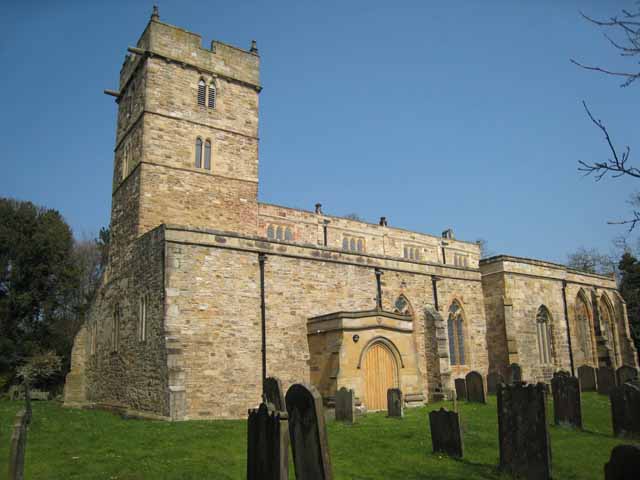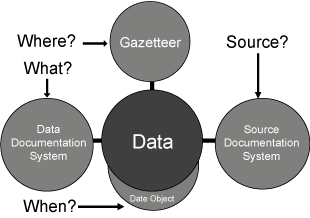|
Helmington Row
Helmington Row is a small village in County Durham, England. It is situated between Crook and Willington, about 7 miles south-west of Durham and 3 miles north-north-west of Bishop Auckland. It has its own park known locally as the Rec, and a petrol station. The village is on the main bus route from Crook to DurhamCrook Golf Clublies to the North of the village. The village itself consists of several terraced streets with the almost totally abandoned Bowden Close within its boundaries. There are around 6 main streets in the main block of houses (3 of those are very popular, Church Street, East View and Russ Street), other streets are situated along the road (not counted). In the 2001 census Helmington Row had a population of 228. There are two sets of allotments where local people may grow their own fruit and vegetables and keep small amounts of livestock. The village once boasted several pubs, The Bowden Inn, the Shoulder of Mutton, The Helmington Inn and the Colliery Inn. ... [...More Info...] [...Related Items...] OR: [Wikipedia] [Google] [Baidu] |
County Durham
County Durham ( ), officially simply Durham,UK General Acts 1997 c. 23Lieutenancies Act 1997 Schedule 1(3). From legislation.gov.uk, retrieved 6 April 2022. is a ceremonial county in North East England.North East Assembly �About North East England. Retrieved 30 November 2007. The ceremonial county spawned from the historic County Palatine of Durham in 1853. In 1996, the county gained part of the abolished ceremonial county of Cleveland.Lieutenancies Act 1997 . Retrieved 27 October 2014. The is the of [...More Info...] [...Related Items...] OR: [Wikipedia] [Google] [Baidu] |
County Durham (district)
County Durham is a unitary authority in the ceremonial county of Durham, North East England. It covers the former non-metropolitan county and its seven districts: Durham (city), Easington, Sedgefield (borough), Teesdale, Wear Valley, Derwentside, and Chester-le-Street. It is governed by Durham County Council and has 136 civil parishes. The district is in a ceremonial county with three boroughs: Borough of Darlington, Borough of Hartlepool & Borough of Stockton-on-Tees (area north of the River Tees). The area is 2,232.6 km2 (862 sq m). History The district was created on the 1 April 2009, following the merger of all the borough and districts (Excluding the boroughs of Darlington, Hartlepool and Stockton-on-Tees) which were already unitary authorities and the towns of Gateshead, Jarrow, South Shields and the city of Sunderland were already part of the Tyne and Wear metropolitan county from 1974. Geography The district has multiple hamlets and villages. Settlements w ... [...More Info...] [...Related Items...] OR: [Wikipedia] [Google] [Baidu] |
Crook, County Durham
Crook is a market town in the district and ceremonial county of County Durham, Northern England. The town is located on the edge of Weardale, therefore is sometimes referred to as the "Gateway to Weardale". The town is in an unparished area, until 1974 it was in Crook and Willington Urban District and was parished. It is located a couple of miles north of the River Wear, Crook lies about 9 miles (14.5 km) south-west of the historic city of Durham, 5 miles (8 km) north-west of Bishop Auckland and 2 miles (3.5 km) from Willington. The A690 road from Durham turns into the A689 leading up through Wolsingham and Stanhope into the upper reaches of Weardale (an Area of Outstanding Natural Beauty). The centre of Crook, a designated conservation area, features a variety of shops and businesses with the market held on Tuesdays and a few stalls on a Saturday. There are two prominent churches, the centrally located St Catherine's CE and Our Lady Immaculate & St Cut ... [...More Info...] [...Related Items...] OR: [Wikipedia] [Google] [Baidu] |
Willington, County Durham
Willington is a former mining village in County Durham, England, in the foothills of the Pennines and near the River Wear close to Crook, County Durham, Crook, Bishop Auckland and Durham City. Like many communities in the area Willington's economy was largely based on coal mining. The closure of the colliery in 1967 therefore affected the local economy. Since 2000 the area has benefited from housing development and increased transportation links. Although a handful of job opportunities remain, work for many residents is now located outside the village, and Willington functions largely as a satellite village for Bishop Auckland and Durham, England, Durham. Governance An Wards and electoral divisions of the United Kingdom, electoral ward in the same name exists. The population of this ward at the 2011 Census was 9,147. Parkside Academy Is a coeducational secondary school. Parkside Academy has announced that they have been awarded "World Class School" status and that they are the ... [...More Info...] [...Related Items...] OR: [Wikipedia] [Google] [Baidu] |
Durham, England
Durham ( , locally ), is a cathedral city and civil parish on the River Wear, County Durham, England. It is an administrative centre of the County Durham District, which is a successor to the historic County Palatine of Durham (which is different to both the ceremonial county and district of County Durham). The settlement was founded over the final resting place of St Cuthbert. Durham Cathedral was a centre of pilgrimage in medieval England while the Durham Castle has been the home of Durham University since 1832. Both built in 11th-century, the buildings were designated as a World Heritage Site by UNESCO in 1986. HM Prison Durham is also located close to the city centre and was built in 1816. Name The name "Durham" comes from the Brythonic element , signifying a hill fort and related to -ton, and the Old Norse , which translates to island.Surtees, R. (1816) ''History and Antiquities of the County Palatine of Durham'' (Classical County Histories) The Lord Bishop of D ... [...More Info...] [...Related Items...] OR: [Wikipedia] [Google] [Baidu] |
Bishop Auckland
Bishop Auckland () is a market town and civil parishes in England, civil parish at the confluence of the River Wear and the River Gaunless in County Durham (district), County Durham, northern England. It is northwest of Darlington and southwest of Durham, England, Durham. Much of the town's early history surrounds the Bishop of Durham, Bishops of Durham and the establishment of Auckland Castle's predecessor, a hunting lodge, which became the main residence of Durham Bishops. This is reflected in the first part of the town's name. During the Industrial Revolution, the town grew rapidly as coal mining took hold as an important industry. Decline in the coal mining industry during the late twentieth century has changed the largest sector of employment to manufacturing. Since 1 April 2009, the town's local authority has been Durham County Council. The unitary authority replaced the previous Wear Valley District and Durham County councils. The parliamentary constituency of Bishop Auc ... [...More Info...] [...Related Items...] OR: [Wikipedia] [Google] [Baidu] |
United Kingdom Census 2001
A nationwide census, known as Census 2001, was conducted in the United Kingdom on Sunday, 29 April 2001. This was the 20th UK census and recorded a resident population of 58,789,194. The 2001 UK census was organised by the Office for National Statistics (ONS) in England and Wales, the General Register Office for Scotland (GROS) and the Northern Ireland Statistics and Research Agency (NISRA). Detailed results by region, council area, ward and output area are available from their respective websites. Organisation Similar to previous UK censuses, the 2001 census was organised by the three statistical agencies, ONS, GROS, and NISRA, and coordinated at the national level by the Office for National Statistics. The Orders in Council to conduct the census, specifying the people and information to be included in the census, were made under the authority of the Census Act 1920 in Great Britain, and the Census Act (Northern Ireland) 1969 in Northern Ireland. In England and Wales the ... [...More Info...] [...Related Items...] OR: [Wikipedia] [Google] [Baidu] |
Medieval
In the history of Europe, the Middle Ages or medieval period lasted approximately from the late 5th to the late 15th centuries, similar to the post-classical period of global history. It began with the fall of the Western Roman Empire and transitioned into the Renaissance and the Age of Discovery. The Middle Ages is the middle period of the three traditional divisions of Western history: classical antiquity, the medieval period, and the modern period. The medieval period is itself subdivided into the Early, High, and Late Middle Ages. Population decline, counterurbanisation, the collapse of centralized authority, invasions, and mass migrations of tribes, which had begun in late antiquity, continued into the Early Middle Ages. The large-scale movements of the Migration Period, including various Germanic peoples, formed new kingdoms in what remained of the Western Roman Empire. In the 7th century, North Africa and the Middle East—most recently part of the Eastern Roman ... [...More Info...] [...Related Items...] OR: [Wikipedia] [Google] [Baidu] |
Rising Of The North
The Rising of the North of 1569, also called the Revolt of the Northern Earls or Northern Rebellion, was an unsuccessful attempt by Catholic nobles from Northern England to depose Queen Elizabeth I of England and replace her with Mary, Queen of Scots. Background Elizabeth I succeeded her half-sister Mary I as queen of England in 1558. Elizabeth's accession was disputed due to the questioned legitimacy of the marriage of her parents (Henry VIII and Anne Boleyn), and Elizabeth's own questioned legitimacy due to the Act of Succession 1536. Under Henry VIII and his advisor Thomas Cromwell, power was gradually shifted from regional institutions to royal control. This course was encouraged by Elizabeth's counsellors such as William Cecil and a policy of centralization was the approach favoured by Elizabeth herself at least in regards to the northern border region. Opponents of Elizabeth looked to Mary, Queen of Scots, the descendant of Henry VIII's sister Margaret. The claims were ... [...More Info...] [...Related Items...] OR: [Wikipedia] [Google] [Baidu] |
Township (England)
In England, a township (Latin: ''villa'') is a local division or district of a large parish containing a village or small town usually having its own church. A township may or may not be coterminous with a chapelry, manorialism, manor, or any other minor area of local administration. The township is distinguished from the following: *Vill: traditionally, among legal historians, a ''vill'' referred to the tract of land of a rural community, whereas ''township'' was used when referring to the tax and legal administration of that community. *Chapelry: the 'parish' of a chapel (a church without full parochial functions). *Tithing (country subdivision), Tithing: the basic unit of the medieval Frankpledge system. 'Township' is, however, sometimes used loosely for any of the above. History In many areas of England, the basic unit of civil administration was the parish, generally identical with the Parish#Ecclesiastical parish, ecclesiastical parish. However, in some cases, particularly ... [...More Info...] [...Related Items...] OR: [Wikipedia] [Google] [Baidu] |
Brancepeth
Brancepeth is a village and civil parish in County Durham, in England. It is situated about from Durham on the A690 road between Durham and Weardale. The population of the civil parish taken at the 2011 census was 414. Brancepeth Castle was until 1570 the fortress of the Neville Earls of Westmorland. The castle was extensively modified and rebuilt in the 19th century by Viscount Boyne (later Baron Brancepeth). It was later a military hospital. St Brandon's Church was famed for its exceptional 17th-century woodwork, until it was destroyed in a major fire in 1998; the church has since been restored and reroofed. In 1924, Harry Colt Henry Shapland "Harry" Colt (4 August 1869 – 21 November 1951) was a golf course architect born in Highgate, England. He worked predominantly with Charles Alison, John Morrison, and Alister MacKenzie, in 1928 forming Colt, Alison & Morrison ... laid out a golf course on the deer park which formed part of the estate surrounding the castle. ... [...More Info...] [...Related Items...] OR: [Wikipedia] [Google] [Baidu] |
A Vision Of Britain Through Time
The Great Britain Historical GIS (or GBHGIS) is a Spatial Database, spatially enabled database that documents and visualises the changing human geography of the British Isles, although is primarily focussed on the subdivisions of the United Kingdom mainly over the 200 years since the first Census Act 1800, census in 1801. The project is currently based at the University of Portsmouth, and is the provider of the website ''A Vision of Britain through Time''. NB: A "GIS" is a geographic information system, which combines map information with statistical analysis, statistical data to produce a visual picture of the iterations or popularity of a particular set of statistics, overlaid on a map of the geographic area of interest. Original GB Historical GIS (1994–99) The first version of the GB Historical GIS was developed at Queen Mary, University of London between 1994 and 1999, although it was originally conceived simply as a mapping extension to the existing Labour Markets Database ... [...More Info...] [...Related Items...] OR: [Wikipedia] [Google] [Baidu] |




_p1.262_-_Brancepeth_Castle%2C_Durham.jpg)


